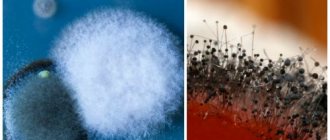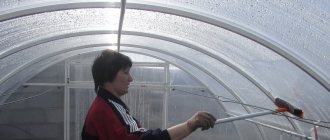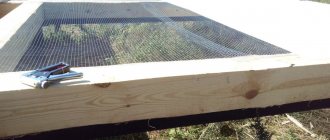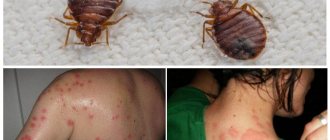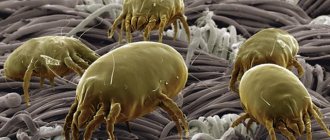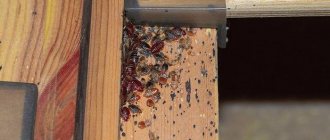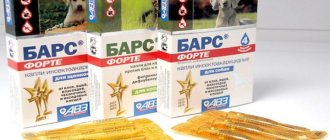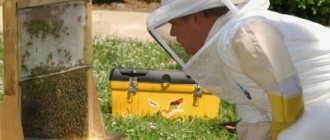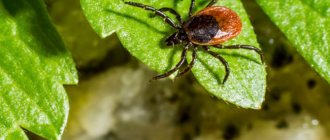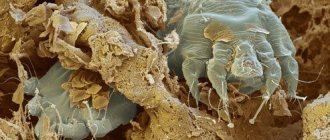Not only household members live with us in our houses and apartments, but also various types of insects. One of them is house ticks. Such a neighborhood is unpleasant and poses a threat to human health. It is very important that more than 150 types of parasites can live in a house, among which are:
- Dust;
- Predatory;
- Krysinykh;
- Lesnykh.
At the same time, dusty and predatory representatives of this class can constantly coexist with people, but forest ones are not permanent residents.
What kind of ticks live in the house?
Bed mite.
This microscopic insect, 0.1 to 0.2 mm, belongs to the genus of saprophagous dust mites. It feeds on dead particles of human skin. Causes allergenic reactions.
Ixodid tick.
These insects do not live in the apartment, but can get into it if they are accidentally brought on clothes. An insect can also sneak into a home on the fur of a dog or cat. By the way, animals can also bring scabies mites into the house.
Dust mite.
The insect constantly lives in house dust, barely reaching 0.2 mm in size. Causes severe allergic reactions.
Spider mite.
Lives on indoor plants, causing them harm.
Destruction of ticks
To get rid of insects, you should carry out a radical cleaning of the entire apartment. It is important to destroy all dust deposits. The fact is that it contains dead particles of human and pet skin, which are exfoliated from the body every day - this is a natural process. Bacteria and fungi settle on them: they are also attractive to ticks as a food source. Therefore, most insects collect in dust, bedding and carpets.
Cleaning the premises alone will not be enough. It will require processing of furniture and household items, as well as washing bed linen in hot water followed by ironing at a high temperature on the surface of the iron.
It is recommended to use additional remedies against ticks: folk remedies and store-bought ones. This way the result of all manipulations will be better. To prevent mites from returning again, you will need to constantly maintain cleanliness in the apartment at an acceptable level. You also need to remember that they do not tolerate low temperatures and drafts well, so the rooms should be regularly ventilated even in the cold season.
Room treatment
The “basic” is cleaning the room, including all the cracks and far corners. To do this, it is recommended to take out all unnecessary things (they also need to be cleaned of dust and treated), including carpets. Curtains and other home textiles are also sent for washing. You need to try to vacate the room as much as if it needed some cosmetic repairs. To gain access to the baseboards, furniture is moved away from the walls.
You need to start cleaning from the top. If you do otherwise, dust and mites will fall down onto the already washed area.
Sample list of tasks:
- Sweep all corners, baseboards under the ceiling and walls.
- Wipe down curtain rods and light fixtures.
- Clean hard furniture surfaces from dust.
- Wipe down the window frame and door frame.
- Wash hard-to-reach areas behind radiators.
- Wash the floor and baseboards.
- Ventilation of the room.
If there are sections of wallpaper in the room that are detached from the walls, then ticks can hide behind them. Therefore, if possible, you should put a “patch” or glue them.
Additional funds
To achieve the best effect, you should use not plain water, but solutions of chemicals and improvised means, or essential oils. They have disinfecting properties, which is necessary when living near dust mites. For example, you can use:
- Bleach. Today, chlorine solution can be bought at any hardware store or supermarket department: it is present in the popular “Whiteness” or ACE bleach. To prepare a liquid for cleaning premises, you should dilute a little chlorine-containing product in a bucket of water, and then mix the solution well. In addition, you can purchase bleach directly in powder form, and then dilute it according to the instructions. Such liquids are traditionally used to disinfect premises for various purposes, including medical ones. The only drawback of bleach is the pungent odor, so the apartment will have to be ventilated after using it. Also, when cleaning, you need to work with gloves to protect your hands.
- Solutions of soda or salt. These products are available in every home, and they are very inexpensive, so their use is accessible to everyone. Other advantages are safety for people and pets, as well as the absence of any odor. The optimal “recipe” for preparing a working solution is 1 handful of salt or soda per 10 liter bucket of water. If you overdo it, then after cleaning, unsightly white stains will remain on the floor and surfaces.
- Other chemicals intended for disinfection: for example, Sanox.
- Essential oils (lemon, lavender, wormwood). They are of natural origin and produce a good disinfectant effect. Due to their safety, they are quite versatile, although in rare cases they can cause allergies or headaches in those who cannot stand the smell of these plants. The aroma usually remains in the room for 1–2 days.
These products are recommended to be used not only for cleaning floors, but also for treating hard surfaces of furniture, cornices, chandeliers, etc. If the surface of an object often comes into contact with human skin (for example, a desktop), then it should be treated with a solution of “folk” products (salt, soda and essential oil), or after treatment with chemicals, wipe with a damp cloth after a while. Chemicals may cause an allergic reaction on the skin.
You can also use technology to combat domestic ticks. For example, an air purifier or a vacuum cleaner with an aqua filter.
Processing of household items and clothing
Soft toys, bedspreads, mattresses, clothes, etc. collect a lot of dust, so they are also a haven for mites. They are processed like this:
- Everything that can be washed in hot water goes into the washing machine. There are special acaricide additives with anti-allergenic effects.
- After the items have dried, they should be ironed at high temperature.
- All carpets, mattresses, blankets and rugs are taken outside and beaten well. They are then left outdoors for several hours. This is especially effective in summer and winter, because ticks are afraid of high and low temperatures.
- One option is irradiation with an ultraviolet lamp.
You can also spray things with special sprays with a natural composition. It is not recommended to use toxic pesticides, because household members will come into contact with them. The exception is floor coverings - special sprays and aerosols with an acaricidal effect have been produced for them.
Furniture processing
The hard surface of furniture - shelves, tables, cabinets - is wiped of dust with a damp cloth. It is advisable to moisten it with a solution that produces a disinfectant effect.
If you are treating furniture with doors or drawers, then they need to be opened (pull out) to thoroughly dry and ventilate.
Things are more difficult with soft surfaces. There are few ways to get rid of ticks in a sofa. It is not advisable to wet such furniture, because it will take a very long time to dry and mold may develop. The use of chemicals is also not recommended. Therefore, the optimal way to treat beds, sofas and armchairs is to use an aerosol and spray with a natural composition. The hard case can be treated with a disinfectant solution. Before cleaning, you need to go over the surface of the sofa with a dust beater.
Chemicals for home control
You can treat your apartment against ticks yourself, provided you follow safety rules. There are many special products on sale:
Bedlam Plus
Acaril
All-Rug
X-mite
Allergoff
"Dobrohim Micro"
"Raid"
Akaitoks
Cypermethrin
Tea tree oil
Spray Easi Ai
Special means
To make it easier to combat domestic ticks, special products are produced. They have an acaricidal effect, destroying mites, and reduce the level of allergic hazard. For example this:
- Allergoff spray, containing toxic substances of chemical origin permethrin and benzyl benzoate. They kill dust mites, and the effect lasts for a long time - about six months. This spray has low toxicity, so it is considered safe for people and animals.
- Allergoff for washing is produced in the form of powder, packaged in sachets. Contains benzyl benzoate, reriproxyfen and benzyl alcohol. Suitable for both hand and machine wash at temperatures from 10 °C to 60 °C. Protection of linen lasts 3 months.
- EASY AIR – you can find a concentrate, spray and additive. Suitable for cleaning premises and processing personal items. Does not contain pesticides.
- Aerosol "Milbiol" with azadirachtin obtained from melia seed oil. The composition is natural, so the product can also be used to treat beds, mattresses, pillows, etc. In addition, the aerosol has an attractive price
The prices of such products vary greatly. For example, spray 3. EASY AIR costs about 1,500 rubles, while Milbiol, which is similar in effect and also does not contain toxic chemicals, is much cheaper.
To prevent the reappearance of ticks in the house, you need to keep the premises clean: dust and wash the floors in a timely manner. Periodic general cleaning is also required, including moving furniture away and knocking out carpets and mattresses. If living in the same area with ticks has led to health problems, then you need to be examined by a doctor who will prescribe proper treatment.
Main habitats
Treatment should be carried out throughout the apartment, paying special attention to the places where insects usually live. Thus, mites prefer to settle and reproduce on objects that are not frequently treated with cleaning agents.
Among them:
- books;
- blankets;
- pillows;
- mattresses;
- carpets;
- cushioned furniture;
- sections of the wall behind paintings, baseboards;
- sockets;
- window frames;
- cloth;
- pet bedding;
- fabric lampshades.
The whole truth about house ticks?
It is impossible to see dust mites. To do this, you should increase them at least 30 times. They do not suck blood and do not bite; therefore, a person does not experience any physical discomfort, so there is no way to detect them in a timely manner. However, they are provocateurs of various allergic and chronic diseases.
Mites feed on dead skin, which a person loses every day, unnoticed by himself, especially in his sleep. Since we always sleep in a bed, the most common habitat for domestic mites is bedding, mattresses, and even the beds themselves. It is the tick feces that they constantly excrete that cause harm. They contain digestive enzymes that contribute to severe allergic reactions in humans.
Many scientists, conducting research on enzymes, say that constant contact of mites with human skin can cause allergic reactions. The skin becomes most vulnerable to various allergens. In fact, any dust is a huge allergen. Dust can be different: cellulose, wool, dandruff, feather fragments, bacteria, fungi, cotton and much more. However, the first place among dust allergens is occupied by the house mite.
Additional precautions with pets
To prevent pets from becoming carriers of ticks and other insects, it is important to adhere to a number of rules and precautions. Including:
- Regularly vaccinate your pets against ticks and parasites;
- care for the coat and wash it thoroughly, removing ticks;
- If you notice signs of the appearance of pests and the development of the disease (lethargy, fever, coloration of mucous membranes), contact a veterinarian.
Ventilation
Periodic ventilation helps control optimal humidity and temperature levels. During the cold season, ventilation of the room directly contributes to the destruction of pests, including ticks. To increase the effectiveness of the fight against parasites, it is recommended to ventilate the room as a whole and potentially dangerous objects separately - in the open air or on the balcony.
Rugs and slippers
Dirt brought into the apartment from the street is one of the reasons for the development of dust mites and other parasites. A large number of pests live on staircase landings. By using a grate mat at the outer door, it is possible to reduce the number of insects entering the apartment. Changing your shoes when entering the house into slippers also helps reduce the amount of dust and stop the development of mites. Rugs and slippers should be washed periodically for maximum effect and pest control.
Air filter and cleaner
Installing air purifiers with a built-in HEPA filter in an apartment can eliminate up to 90% of dangerous allergens and insects. In order for the purifiers to function properly and resist parasites, the filters should be constantly cleaned. When turning on the air purifier, you must close the windows in the room, otherwise its operation will be ineffective and some of the pests will remain in their original places.
Minimalism
Household clutter contributes to the active collection of dust, the emergence and reproduction of mites and other parasites. By sticking to minimalism and cleaning regularly, you can reduce the risk of insects.
It is recommended to remove all items that strongly attract dust and pests, including unnecessary decorations, books, stacks of papers, picture frames.
If possible, you should reduce the number of decorative pillows on upholstered furniture, and hang blinds instead of fabric curtains. It will also be helpful to remove thick pile carpeting where mites live. It is better to give preference to a tiled or wooden covering. This will not only eliminate dust mites, but will also simplify subsequent cleaning.
Steam generator
A steam generator is a device that heats water to a high temperature and converts it into steam. The equipment is used for processing furniture upholstery, carpets, and bedding. Steam generators differ in power rating, method and pressure of steam release, and other functional features. For home use, it is recommended to purchase a device with a power of at least 800 W. You can spray soft products with steam not only when signs of pest spread are detected, but also for preventive purposes.
See also
How to properly and quickly clean the house, where to start and what stages to divide into
Ozone generator
Ozone is a component of air and has oxidizing and disinfecting properties. Like other gases, ozone penetrates into the thickness of materials and interacts with mold, fungi and harmful microorganisms, including mites. The influence of ozone destroys pests and prevents their further spread.
The device is capable of producing up to 3500 mg of ozone per hour. Regularly turning on the air purification device allows you to destroy all bacteria, sterilize the air and remove unpleasant odors from the room. The ozone generator is easy to use and operates on electricity. To start the device, just plug it into a power outlet and leave it working indoors for the required period of time.
Appearance and causes of appearance
The size of pests can reach 3 mm, but most often the size of insects is 0.1-0.5 mm. Insects are classified as arachnids, and as characteristic representatives of this species, they lack wings. Adult insects have 4 pairs of legs. Orientation in space in ticks occurs due to the sensory apparatus, since they do not have eyes. Pests are able to smell a person at a distance of up to 10 m. Based on their structure, mites are divided into leathery insects with fused head and body, and armored parasites with a movable head.
There are several common causes of pests in summer cottages or in residential premises. Once you discover a parasite infestation, it is important to find out the specific cause to prevent further reproduction.
Neighbours
In suburban areas, ticks can enter the area from neighbors or from the forest. If a neighbor's property has been attacked by a pest and no extermination measures have been taken, then there is a high probability of the insect spreading to adjacent areas.
New things and equipment
The smell of new things often attracts pests. This reason is especially relevant for new technical devices, which usually have a pronounced odor.
Animals
Many animals carry ticks and other insects. Pests live and lay eggs in the fur of dogs, cats and rodents. The population size of pests spread by this method is usually insignificant. You can notice the presence of parasites on pets by frequent scratching and gnawing of fur.
See also
Dimensions and types of waste containers, drawings for the manufacture of tanks
How dangerous are dust mites?
Dust mites themselves do not parasitize the human body and do not bite it. The greatest danger is posed by their waste products. The arachnids leave behind feces about 30 micrometers in diameter containing digestive enzymes (Der f1 and Der p1 proteins) and the P1 antigen. Enzymes help destroy human skin cells, which these microscopic creatures feed on. As a result, the immune system begins to react to them as an allergen, provoking a severe allergic reaction, especially if a person is genetically predisposed to it.
He may have:
- allergic rhinitis;
- respiratory allergies - due to periodic inhalation of mites and their excrement;
- atopic dermatitis;
- conjunctivitis;
- acarodermatitis - due to dust mite bites;
- rhinoconjunctivitis;
- Quincke's edema;
- bronchial asthma.
Allergy
Allergy is a chronic disease caused by an inappropriate and unexpected response of the immune system to substances that the body falsely identifies as dangerous, even though they are not harmful to health. This can be food, pollen, medicines, insect poison, cosmetics. Manifestations of allergies are varied: for example, digestive disorders, cough, shortness of breath, sneezing, itching, watery eyes, red eyes, skin rash.
Symptoms:
- cough;
- facial pain;
- itchy, red or watery eyes;
- itching in the nose, roof of the mouth, or throat;
- nasal congestion;
- nasal discharge;
- runny nose, sneezing;
- swollen blue skin under the eyes.
If dust mite allergy accompanies asthma:
- a whistling or wheezing sound is heard when exhaling;
- have bouts of coughing or wheezing that are made worse by a respiratory virus such as a cold or flu;
- chest tightness or pain;
- labored breathing;
- sleep problems caused by shortness of breath, coughing or wheezing.
The following factors increase your risk of developing dust mite allergies:
- Family history of allergies. In this case, you are more likely to develop sensitivity to dust mites, especially if several close relatives have allergies.
- Work in dusty areas where cleaning is not carried out regularly.
- Age. A person is more likely to develop a dust mite allergy during childhood or early adulthood.
Neighborhood Danger
Neighborhood with ticks is dangerous for humans, even with those insects that do not feed on blood. Bed and dust mites defecate up to 20 times a day. And it is insect excrement that contains enzymes that contribute to the development of contact allergies. Also, the chitinous shell from dead ticks, when crushed into microscopic particles, enters the air and causes irritation of the mucous membranes of the nose and mouth.
Dust and bed mites cause:
- dermatitis;
- asthma;
- tearfulness;
- rhinitis;
- sneezing;
- cough;
- itching;
- rashes.
Ixodid mites are no less dangerous to humans, although they do not appear in their homes very often, unlike bed and dust mites. These insects are carriers of diseases, and when they bite, pathogens enter the open wound, which leads to serious complications.
Ixodid ticks cause the development of:
- tick-borne encephalitis;
- borrelosis (Lyme disease);
- fevers, etc.
To avoid unpleasant consequences from various types of mites, you need to know what you can use to treat the room. This will get rid of this unpleasant neighborhood and protect all the inhabitants of the house.
Bites on the skin
